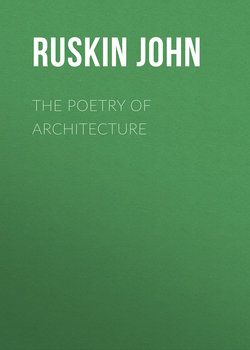The Poetry of Architecture

Реклама. ООО «ЛитРес», ИНН: 7719571260.
Оглавление
Ruskin John. The Poetry of Architecture
PREFATORY NOTES
INTRODUCTION
PART I. The Cottage
I. THE LOWLAND COTTAGE—ENGLAND AND FRANCE
II. THE LOWLAND COTTAGE—ITALY
III. THE MOUNTAIN COTTAGE—SWITZERLAND
IV. THE MOUNTAIN COTTAGE—WESTMORELAND
V. A CHAPTER ON CHIMNEYS
VI. THE COTTAGE—CONCLUDING REMARKS
PART II. The Villa
I. THE MOUNTAIN VILLA—LAGO DI COMO
II. THE MOUNTAIN VILLA—LAGO DI COMO (Continued)
III. THE ITALIAN VILLA (Concluded)
IV. THE LOWLAND VILLA—ENGLAND
V. THE ENGLISH VILLA.—PRINCIPLES OF COMPOSITION
VI. THE BRITISH VILLA.—PRINCIPLES OF COMPOSITION
The Cultivated, or Blue Country and the Wooded, or Green Country
A. The Simple Blue Country
B. The Picturesque Blue Country
C. The Woody or Green Country
VII. THE BRITISH VILLA.—PRINCIPLES OF COMPOSITION
D. Hill, or Brown Country
Отрывок из книги
1. The Science of Architecture, followed out to its full extent, is one of the noblest of those which have reference only to the creations of human minds. It is not merely a science of the rule and compass, it does not consist only in the observation of just rule, or of fair proportion: it is, or ought to be, a science of feeling more than of rule, a ministry to the mind, more than to the eye. If we consider how much less the beauty and majesty of a building depend upon its pleasing certain prejudices of the eye, than upon its rousing certain trains of meditation in the mind, it will show in a moment how many intricate questions of feeling are involved in the raising of an edifice; it will convince us of the truth of a proposition, which might at first have appeared startling, that no man can be an architect, who is not a metaphysician.
2. To the illustration of the department of this noble science which may be designated the Poetry of Architecture, this and some future articles will be dedicated. It is this peculiarity of the art which constitutes its nationality; and it will be found as interesting as it is useful, to trace in the distinctive characters of the architecture of nations, not only its adaptation to the situation and climate in which it has arisen, but its strong similarity to, and connection with, the prevailing turn of mind by which the nation who first employed it is distinguished.
.....
Oct. 12, 1837
37. In the three instances of the lowland cottage which have been already considered, are included the chief peculiarities of style which are interesting or important. I have not, it is true, spoken of the carved oaken gable and shadowy roof of the Norman village; of the black crossed rafters and fantastic proportions which delight the eyes of the German; nor of the Moorish arches and confused galleries which mingle so magnificently with the inimitable fretwork of the gray temples of the Spaniard. But these are not peculiarities solely belonging to the cottage: they are found in buildings of a higher order, and seldom, unless where they are combined with other features. They are therefore rather to be considered, in future, as elements of street effect, than, now, as the peculiarities of independent buildings. My remarks on the Italian cottage might, indeed, be applied, were it not for the constant presence of Moorish feeling, to that of Spain. The architecture of the two nations is intimately connected: modified, in Italy, by the taste of the Roman; and, in Spain, by the fanciful creations of the Moor. When I am considering the fortress and the palace,4 I shall be compelled to devote a very large share of my attention to Spain; but for characteristic examples of the cottage, I turn rather to Switzerland and England. Preparatory, therefore, to a few general remarks on modern ornamental cottages, it will be instructive to observe the peculiarities of two varieties of the mountain cottage, diametrically opposite to each other in most of their features; one always beautiful, and the other frequently so.
.....